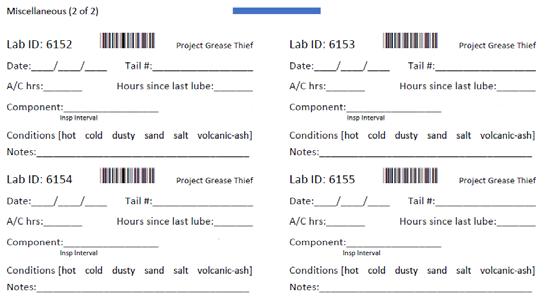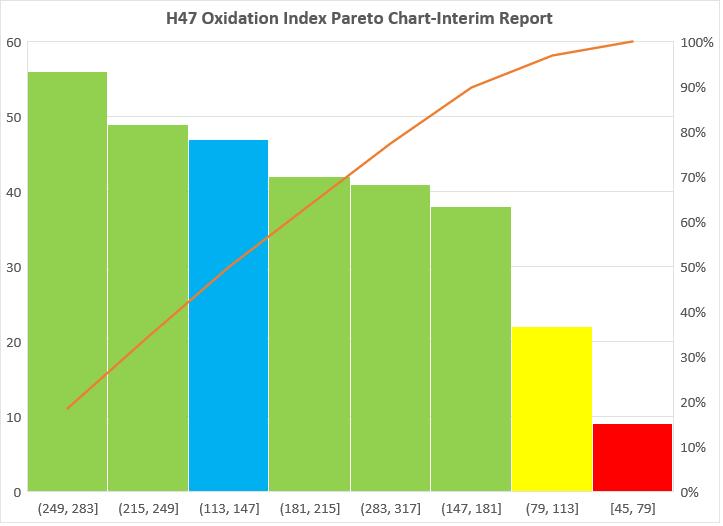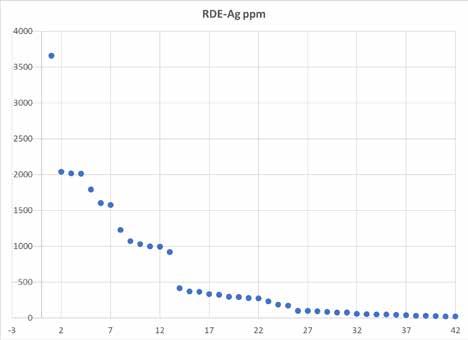
10 minute read
Optimizing Maintenance and Flight Safety with In-Service Grease Analysis
Rich Wurzbach, MRG Labs, York, PA, USA Michael Johnson, AMRRI, Franklin, TN, USA
Abstract
Rotary-wing aircraft such as helicopters rely on flight controls and drivetrains that contain multiple grease-lubricated components including bearings, swashplates, and splines. Periodic relubrication of these components during established maintenance intervals is the primary method for replenishment of grease prior to degradation, to ensure reliable and safe operation of assets. A project was completed to develop techniques for sampling and analyzing grease from the drivetrain components of rotarywing aircraft.
The project was developed to evaluate the effectiveness of existing maintenance intervals, and to develop engineering data sets to propose interval adjustments. Such adjustments could be made to enhance safety and performance, while finding opportunities to reduce manpower and operational costs. This project incorporates new technologies including the use of sampling tools outlined in ASTM D7718, and new analysis methods that allow for small sample volume evaluation of component wear, as well as grease contamination, oxidation, and consistency changes.
This paper will present the progress that has been made: 1) development of means to obtain representative samples from bearings, swashplates and splines; 2) data analysis methods that combine maintenance and operating histories with grease analysis results; and 3) findings that may lead to safer and more economical operation of critical assets.
Background
Continuous evaluation and enhancement of flight safety, reliability, and cost-effectiveness are at the core of aircraft operations and maintenance. This applies both to newly designed and developed platforms, and those that have been in operation for many years. Some designs, particularly in military applications, have been utilized effectively for decades.
New technologies have emerged that can aid in this continuous evaluation to find applications to ensure the continued safe and reliable operation of these assets. Grease analysis has lagged significantly behind oil analysis for many years, not only in aerospace assets, but for lubricated machinery of all types. Over the last 10 years, advancements have been made to address the two main barriers to effective grease monitoring: obtaining representative samples, and having a meaningful test slate that can be applied to very small sample sizes.
The purpose of this study is to reinforce the engineering basis for grease replenishment and servicing intervals for deployed aircraft. This study has produced significant findings related to the consistency, oxidation state, and contamination of in-service greases as well as levels of wear, thus providing a basis for data-driven decisions related to reliability, flight safety, and cost of operation of helicopters.
Sampling Methodology Development
The sampling approach chosen for this project follows the principles and tools outlined in the American Society of Testing and Materials (ASTM) Standard D7718, “Standard Practice for Obtaining In-Service Samples of Lubricating Grease”. This practice details the methods and precautions necessary to obtain representative samples of in-service grease, and tools that enable the collection of these samples.
Initially, a basic kit configuration was used in a trial on disassembled components in the inspection facility of an aircraft manufacturer. The purpose of this trial was to obtain samples and identify challenges and needed modifications of the basic kit. After testing several components, including driveshaft spline connectors, swashplates, and bearings, a new kit was designed to optimize the sample collection process by the technicians servicing the aircraft at regular intervals.
The kit mostly resembled existing sampling kits for pillow (plummer) block bearings, with a minor modification of reduction of the length of the syringe nozzle of the sample collection device. The nozzle was shortened to be nearly flush with the body of the sample collection syringe. The spline areas typically were found with very little grease, and the nozzle was shortened in an effort to minimize the loss during transfer to the final analysis container, referenced in the ASTM D7718 standard as the “Passive Sampling Device”. The shortening of the syringe tip resulted in no real loss of functionality, but gave a better yield of the available grease for the sample.
Figure 1 Kit for collecting a grease sample
Labeling of samples was a very important consideration, as the collection of conditional data and proper identification of the aircraft and aircraft sampling point are critical to ensuring data integrity. Guidance for labeling was also found in the ASTM D7718 standard. The specific label format used in this study can be seen in Figure 2. This figure shows a “miscellaneous” label, which did not include the designation for specific locations. Most other labels were pre-printed with a designated sample point name for uniformity of data collection, which greatly improved the processing of samples in the lab. The use of barcodes also helped to minimize the possibility of improper sample point identification during data entry.
Figure 2 Miscellaneous labels

Selection Of Analysis Tests
A second ASTM Standard, D7918, was utilized in the establishment of the test slate to be applied in this study. In order to determine the optimal grease service interval, several degradation and loss of functionality modes were evaluated. Replenishment of grease is performed ideally when grease nears the end of its oxidative life, which is a function of physical work and shearing, temperature, moisture, and other oxidation stressors.
Replenishment is also used as a tool to purge contaminants that work their way from the surrounding environment to the load zones of the greased components.
Changes in consistency, either softening or hardening, interfere with the grease functionality and can lead to loss of lubrication and protection. Any loss of grease functionality that results in an increase in wear rate puts the reliability and life of the component at risk. Therefore, all of these parameters should be monitored to determine the optimal service interval for replenishing the grease.
The test slate utilized five tests from the D7918 method, which were discussed in detail in a previous paper (Wurzbach 2018): • Ferrous debris level (ppm), • Colorimetry, • Die Extrusion (consistency), • Linear Sweep Voltametry (anti-oxidant levels), • Moisture (ppm).
Additionally, Fourier Transform Infrared Spectroscopy (FTIR) was performed to compare sample composition with the identified baseline, and Rotating Disc Electrode (RDE) elemental spectroscopy was used to quantify contaminants and non-ferrous wear elements. Analytical Ferrography was performed on all grease samples to further characterize the type and nature of wear and other particulates extracted from the grease.
These eight tests were and are being used for several reasons: 1) to gain insight into the performance of grease over the existing service intervals, 2) to find outlier conditions that result in abnormal changes in grease condition or wear, and 3) to use statistical tools on the remaining samples (those without abnormal changes) to project opportunities to optimize re-lubrication frequencies by either increasing or decreasing these intervals.
Data Indications
Several new findings from this project have contributed to improvements in the sampling process, established relationships between measured parameters and observed grease and component conditions, and led to revised guidance for grease replenishment intervals.
First, one accomplishment is a method for the overall summary of the state of oxidation of samples taken from multiple locations across the airframe. Oxidation was evaluated by quantification of the remaining levels of anti-oxidants in the grease samples as measured by linear sweep voltammetry. Since some of the greases contained one identified anti-oxidant, and others contained two (e.g., an amine and a phenol), an “Oxidation Index” was created in order to compare these greases.
The Oxidation Index weights the contributions of these anti-oxidants and compares greases with different types of anti-oxidant systems. The Oxidation Index is a scale from zero to a maximum value of 300 for samples containing the full amount of anti-oxidant additives present in new greases. For a grease with a single anti-oxidant, the percentage remaining is multiplied by three (X3). For a greases with two or more anti-oxidants, the percentage remaining of the amine anti-oxidant is added to two times (2X) the percentage remaining of the phenol anti-oxidant. This puts a heavier weighting on those samples that still have significant phenolic component remaining in the synergistic mixture of anti-oxidants.
On this new index scale, 150 refers to those greases with significant (perhaps more than half) of their resistance to oxidation remaining. These greases are candidates for consideration of extension of regreasing intervals, at least as compared to replenishment required for greases approaching the end of their oxidative life.
A graph that was generated early in the project showed that most samples showed significant remaining oxidative life, as seen in Figure 3. Figure 3 is a Pareto Chart where the Y-axis shows the number of grease samples with values of the Oxidative Index corresponding to each range shown on the X-axis. The red line shows the cumulative contribution of those values, such that 90% of the samples were either in the “Excellent” oxidative condition (Oxidative Index >150, green) or “Good” oxidative conditions (150 > Oxidative Index >100, blue). Of the few samples that fell into the “Marginal” (yellow) or “Poor” (red) classes, most were found to have been mixed samples or without a proper baseline reference.
Figure 3 Pareto chart of Oxidative Index values of grease samples

Second, significant silver (Ag) levels were found in grease samples from several locations. The graph in Figure 4 shows silver levels that were found in excess of 1000 ppm in several of the spline samples. Even in greases, such high concentrations of rarer elements such as silver are not typically found in lab samples. Further investigation showed that silver was being used as an anti-fretting coating on the component parts.
Figure 4 Levels of silver (ppm) in 42 grease samples measured by RDE

Third, moderate to low wear levels and relatively low contaminant levels were found in grease samples from most components tested. Additionally, the consistency of the grease, as measured by Die Extrusion, changed only moderately in most samples. These findings reinforced the known good operating history of these aircraft. Further sampling and analysis allowed the OEM engineers to recommend revised and optimized grease servicing intervals and activities to ensure the continued good flight safety and reliability performance of the evaluated helicopters.
Conclusions And Next Steps
Since the initial presentation of this project in June 2019, a statistically significant database was prepared with data from over 1000 grease samples from more than 20 lubricated locations on the subject helicopters. Calculations and conclusions were made using this database, which serve as the technical basis for grease servicing interval modifications. The results are new, revised recommended intervals for grease lubrication that have resulted in 50% fewer service interruptions for component greasing, and a reduction of 54% of the assigned greasing tasks per 1000 flight hours.
Additional benefits include potential future optimization and even condition-based service intervals when a program of recurring grease sampling and analysis is utilized to monitor the health of both the grease and the components while under inspection. The results from these grease sampling and analysis activities are already demonstrating the potential for further enhancing aircraft reliability and safety through the identification and the incorporation of improved practices, materials, and guidance for grease service tasks.
A complete presentation of results and findings from this project has been slated for presentation at the 76th Annual Forum of the Vertical Flight Society in October 2020.
Acknowledgements
This paper was based on a presentation given at the 86th Annual NLGI Meeting, June 8-11th, 2019, at JW Marriott Resort, Las Vegas, Nevada, USA.
References
ASTM D7718-11(2019), Standard Practice for Obtaining In-Service Samples of Lubricating Grease, ASTM International, 100 Barr Harbor Drive, PO Box C700, West Conshohocken, PA, 19428-2959 USA
ASTM D7918 - 17a Standard Test Method for Measurement of Flow Properties and Evaluation of Wear, Contaminants, and Oxidative Properties of Lubricating Grease by Die Extrusion Method and Preparation, ASTM International, 100 Barr Harbor Drive, PO Box C700, West Conshohocken, PA, 19428-2959 USA
Wurzbach, R. In-service Grease Testing Techniques That Can Save Money and Time for Grease Manufacturers, The NLGI Spokesman, 82(5), Nov./Dec. 2018.
A compete presentation of results and findings from this project has been slated for presentation at the 76th Annual Forum of the Vertical Flight Society in October 2020.





